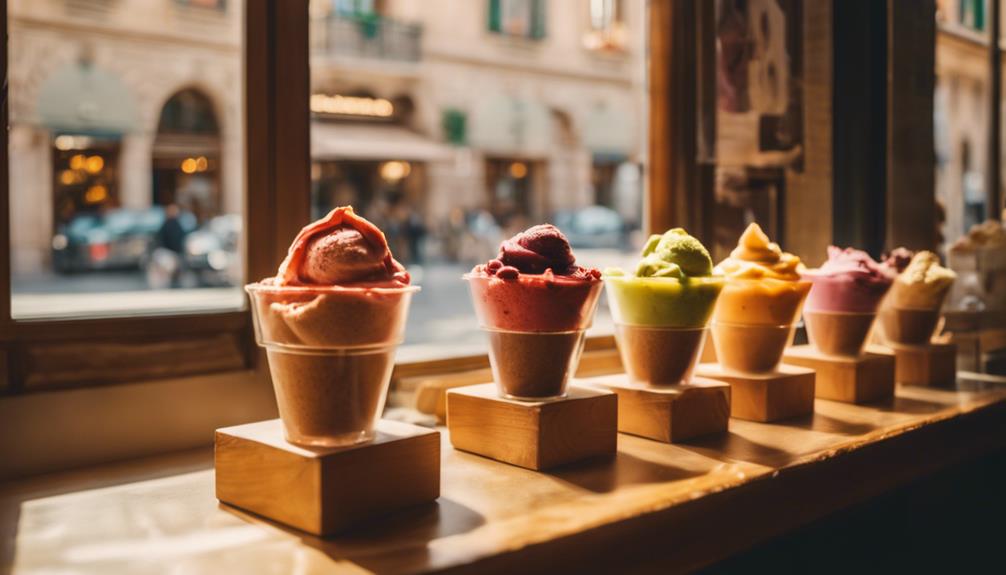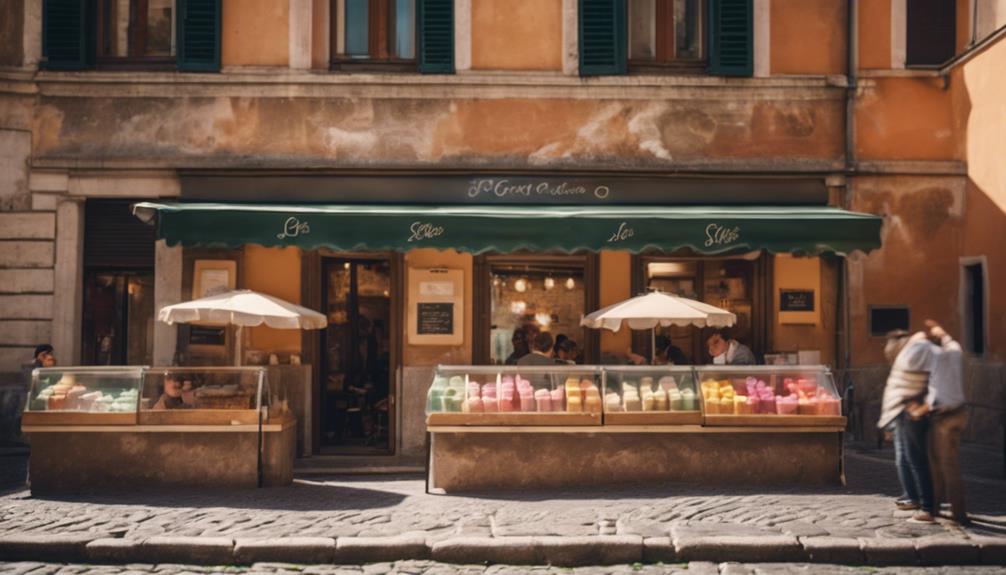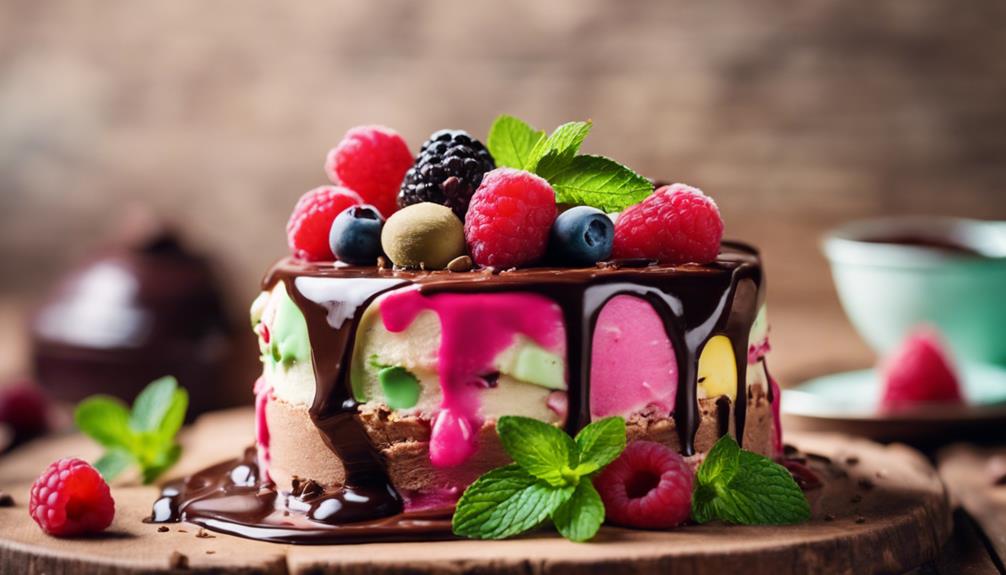If you are looking for the best gelato in Bologna, make sure to visit Cremeria Santo Stefano for unique flavors like matcha tea and saffron. La Sorbetteria di Castiglione offers Dolce Emma, a seasonal treat made with caramelized figs, ricotta, and lemon. Gelateria Gianni has 40 flavors available daily, including local pistachio and rich chocolate. Be sure to try Venchi’s exceptional strawberry gelato and explore the creative options at Gelato Lab. These gelaterias prioritize fresh, natural ingredients and unique combinations, guaranteeing a delightful experience. Stay tuned for more insider suggestions on where to find the sweetest treats!
Key Takeaways
- Cremeria Santo Stefano and La Sorbetteria di Castiglione are top-rated gelaterias known for their unique and seasonal flavors.
- Gelateria Gianni offers a wide variety of 40 flavors daily, perfect for classic and modern gelato lovers.
- Seasonal specialties like saffron and pumpkin with black pepper provide unique tasting experiences throughout the year.
- Enjoy gelato al fresco at local shops that serve as community gathering spots, enhancing your experience.
Top Gelaterias in Bologna

When you're in Bologna, you can't miss the top gelaterias that offer a delightful array of flavors and unforgettable experiences.
One of the most celebrated spots is Cremeria Santo Stefano, often regarded as the best gelato in Bologna. Here, you'll find unique flavors like matcha tea and saffron, all served with a creamy texture that keeps locals coming back for more.
Another must-visit is La Sorbetteria di Castiglione at Via Castiglione 44. Known for its signature flavor, Dolce Emma, this gelato shop features a delicious blend of caramelized figs, ricotta, and lemon, making it a favorite among gelato enthusiasts.
Don't overlook Gelateria Gianni, where you can choose from a staggering 40 flavors daily, including their rich chocolate gelato and pistachio options, crafted with local dairy.
Lastly, Venchi Gelato and Cioccolato, located at Via degli Orefici 23, tempts you with exceptional strawberry gelato and a variety of chocolate flavors.
These gelato shops in Bologna truly elevate your sweet experience, ensuring your visit is both tasty and memorable.
Unique Flavors to Try

When you're in Bologna, don't miss out on the unique flavors that set its gelato apart.
Seasonal limited editions showcase fresh, local ingredients, while exotic ingredient combinations invite you to try something truly different.
Explore these standout options and treat your taste buds to an unforgettable experience!
Seasonal Limited Editions
Bologna's gelaterias, like Cremeria Santo Stefano and La Sorbetteria Castiglione, tempt you with seasonal limited edition flavors that celebrate local ingredients and traditions. These gelato shops in Bologna often craft unique seasonal flavors that reflect the essence of the region, making every visit an adventurous tasting experience.
Here are some must-try limited edition flavors:
- Saffron: A rich, aromatic gelato that highlights a prized local spice.
- Pumpkin with Black Pepper: A savory-sweet blend perfect for autumn.
- Turmeric with Cinnamon: A warm, spiced treat that's both exotic and comforting.
- Fresh Peach: A rejuvenating, fruity delight available during the summer.
These seasonal flavors change frequently, enticing you to return and discover something new.
You'll find that many gelato shops create unique offerings inspired by local festivals, ensuring that every scoop is a taste of Bologna's rich culture.
Don't miss out on these limited edition flavors—they're a delicious way to experience the city's culinary creativity!
Exotic Ingredient Combinations
You'll discover a world of exotic ingredient combinations in Bologna's gelaterias, where innovative flavors tantalize your taste buds and push the boundaries of traditional gelato. If you're feeling adventurous, stop by Cremeria Scirocco for standout gelato flavors like pumpkin with black pepper and almond with Gorgonzola. These unique combinations will excite your palate like never before.
At Stefino Gelato Biologico, plunge into dark chocolate gelato infused with ginger and curry, a perfect example of how exotic ingredients can elevate artisan gelato. For a twist on classics, visit Cremeria Santo Stefano to savor creative flavors such as saffron and matcha tea.
Gelateria Gianni offers a rich chocolate gelato that pairs beautifully with unexpected notes of orange and cardamom, creating a delightful tasting experience. Meanwhile, La Sorbetteria di Castiglione captivates with flavors like caramelized figs and lemon, merging traditional and exotic elements seamlessly.
Bologna's gelaterias are truly a playground for the adventurous foodie. Don't miss your chance to sample these unique combinations that redefine gelato flavors and promise unforgettable experiences!
Cultural Importance of Gelato

Gelato holds a cherished place in Italian culture, serving not just as a delightful treat but as a vibrant social experience that brings people together in Bologna's lively atmosphere. When you stroll through the streets, you'll notice locals and visitors alike savoring artisanal gelato, reinforcing its cultural significance in this historic city.
Here are some key aspects of gelato culture in Bologna:
- Historical Roots: Gelato dates back to the Renaissance, making it a symbol of Italian culinary heritage.
- Community Engagement: Festivals dedicated to gelato highlight local artisans and foster a sense of community pride.
- Artisanal Production: Many gelaterias focus on crafting gelato with quality ingredients, ensuring a rich and authentic experience.
- Diverse Flavors: With over 100 gelaterias in Bologna, you can explore an impressive array of flavors that reflect the region's creativity.
In Bologna, gelato is more than just dessert; it's a celebration of tradition and community, making each scoop a sweet reminder of Italian culture.
Gelato Quality Criteria

When evaluating gelato quality, key factors like texture, flavor intensity, and freshness play an important role in delivering an exceptional experience. A truly great gelato should boast a creamy texture that melts in your mouth, free from any iciness. This smoothness is essential for a satisfying taste encounter.
Flavor intensity is equally important; you want to savor the richness that comes from natural ingredients. Avoid gelato made with artificial additives, as they can dull the authentic taste. Freshness is significant too, as the best gelaterias craft their gelato daily, ensuring every scoop is bursting with flavor.
Finally, a variety of flavors can elevate your gelato experience, allowing you to explore both classic and inventive combinations.
Here's a quick summary of these quality criteria:
| Criteria | Importance | Key Features |
|---|---|---|
| Creamy Texture | Essential for mouthfeel | Smooth, no iciness |
| Natural Ingredients | Enhances flavor intensity | Pure, rich taste |
| Freshness | Guarantees ideal quality | Made daily |
Insider Tips for Enjoyment

Sampling multiple flavors before settling on your choice can uncover delightful surprises and seasonal gems at local gelaterias. Don't shy away from trying a few spoonfuls; it's part of the fun!
To enhance your gelato experience, keep these insider tips in mind:
- Visit gelaterias during off-peak hours for a quieter atmosphere and personalized service.
- Look for gelaterias with visible production areas to guarantee you're getting fresh and high-quality gelato.
- Pair your gelato with a local pastry, like brioche, to create a delicious contrast of textures and flavors.
- Be mindful of portion sizes; starting small allows you to enjoy a variety without feeling overwhelmed.
Exploring Bologna's Gelato Scene

When you explore Bologna's gelato scene, you'll discover over 100 gelaterias serving up unique and innovative flavors.
Places like Cremeria Santo Stefano and La Sorbetteria di Castiglione stand out, offering artisanal gelato made with high-quality ingredients.
You'll find that each scoop provides a creamy texture and intense flavor experience, making it worthwhile to try seasonal and limited-time offerings.
Top Gelaterias Overview
Bologna's gelato scene invites you to explore over 100 gelaterias, each showcasing unique flavors and artisanal craftsmanship that delight every palate.
Whether you're searching for the best gelato shop or simply craving delicious gelato, you'll find something special in every corner of the city.
Some highlights of Bologna's top gelaterias include:
- Cremeria Santo Stefano: Known for its rich, creamy textures and innovative flavors.
- La Sorbetteria di Castiglione: A favorite for its authentic Italian gelato made with seasonal, locally sourced ingredients.
- Gelateria Gianni: Offers a fantastic variety of both classic and modern flavors.
- Gelato Lab: A place where creativity meets tradition, making gelato with fresh, natural ingredients.
As you begin your gelato journey, be sure to sample the artisanal offerings, as each gelateria presents its own specialties.
With so many gelato made from passion and tradition, you're bound to discover flavors that will leave you craving more.
Enjoy the delightful experience of Bologna's gelato scene!
Unique Flavor Experiences
Explore the world of unique gelato flavors that invite you to step outside traditional choices and embrace inventive combinations. Bologna's gelato scene is a playground for your taste buds, filled with surprising options that highlight fresh local ingredients.
Here's a glimpse of some must-try gelato experiences:
| Gelateria | Unique Flavor | Description |
|---|---|---|
| Cremeria Santo Stefano | Matcha Tea & Saffron | A harmonious blend that surprises the palate. |
| Cremeria Scirocco | Pumpkin with Black Pepper | A savory twist that's both bold and comforting. |
| La Sorbetteria di Castiglione | Dolce Emma | A sweet mix of caramelized figs, ricotta, and lemon. |
Each gelateria offers seasonal offerings that rotate throughout the year, ensuring you'll discover something new on every visit. Whether it's the organic dark chocolate with ginger at Gelateria Stefino or the almond with Gorgonzola from Cremeria Scirocco, you're bound to find flavors that challenge your expectations and satisfy your sweet tooth. Don't miss out on these unique flavor experiences!
Seasonal and Special Flavors

Seasonal flavors at local gelaterias highlight fresh, vibrant ingredients like figs, peaches, and strawberries, offering unique and revitalizing options that change throughout the year.
You'll find that many gelaterias, such as Cremeria Santo Stefano, introduce limited-time flavors inspired by seasonal produce or holidays, making every visit an opportunity for new tastes.
Here are some seasonal and special flavors you shouldn't miss:
- Pumpkin with black pepper: A surprising yet delightful combination.
- Saffron gelato: A luxurious twist inspired by local cuisine.
- Almond with Gorgonzola: An exclusive specialty, available only during certain seasons.
- Fresh berry medley: Bursting with the flavors of summer.
These seasonal flavors showcase Bologna's commitment to local ingredients and innovation.
The gelato shops often rotate their menus to reflect the changing seasons, ensuring you experience fresh tastes year-round.
With exclusive specialties and innovative combinations, you'll always find something new to indulge in.
Community and Social Aspects

When you enjoy gelato in Bologna, you're not just savoring a treat; you're part of a lively social scene.
Locals frequently gather at gelaterias, sharing their favorite flavors and celebrating seasonal events that unite the community.
These moments transform gelato into a cherished ritual that brings everyone together, making each scoop a shared experience.
Gelato as Social Activity
In Bologna, gelato isn't just a delightful dessert; it's a vibrant social activity that brings people together in bustling gelaterias and under the city's charming porticos.
Whether you're a local or a visitor, indulging in your favorite gelato becomes a way to foster community connections. You'll find that many gelato shops are perfect for people-watching and striking up conversations with friends or family.
Here are some reasons why gelato is a social staple in Bologna:
- Gelato shops often become meeting points for locals.
- Sharing recommendations for the best flavors creates camaraderie.
- Enjoying gelato outdoors reflects the city's lively spirit.
- The city center buzzes with energy as people savor their treats.
As you explore Bologna, don't forget to join in this sweet social activity. Grab a cone or cup of your favorite gelato, and let the delightful flavors spark conversations and laughter.
After all, it's not just about satisfying your sweet tooth; it's about connecting with the vibrant community that makes Bologna so special.
Community Gelato Events
Throughout the year, Bologna comes alive with community gelato events that celebrate local artisans and invite everyone to join in the sweet festivities. These gelato festivals showcase the creativity and craftsmanship of local gelato makers, allowing you to sample unique flavors and learn about the art of gelato-making. You'll find locals and visitors alike gathering at popular gelaterias, chatting about their favorite flavors and discovering new ones.
One of the highlights is 'Gelato Day,' where you can explore various gelato shops and support local businesses while indulging in delightful treats. These community events foster a sense of camaraderie among participants, as everyone shares their love for this delicious dessert.
Additionally, collaborations between gelaterias and local chefs often lead to special events featuring exclusive flavor combinations, highlighting Bologna's rich culinary heritage. If you're keen to dive deeper into the craft, Carpigiani Gelato University offers workshops and courses that engage the public, enriching your understanding of this beloved treat.
Participating in these events not only satisfies your sweet tooth but also strengthens your connection to Bologna's vibrant gelato culture.
Gelato Education Opportunities

Discovering the art of gelato making can start at Carpigiani Gelato University, where you'll find over 400 courses designed to elevate your skills and passion for this delicious frozen treat. Established in 2003, this prestigious institution offers thorough training for aspiring gelatieri, covering everything from ingredient selection to flavor development.
By enrolling in a course, you can expect to:
- Gain hands-on experience in artisanal gelato making
- Learn about the importance of fresh, local ingredients
- Explore various aspects of gelato production
- Network with industry experts and fellow enthusiasts
Whether you're a novice or a seasoned pro, these gelato education opportunities at Carpigiani Gelato University equip you with the knowledge to create high-quality gelato that delights the senses.
You'll not only enhance your technical skills but also cultivate a deeper appreciation for this beloved treat, ensuring your creations stand out in the competitive world of gelato making.
Visual Appeal of Gelato

The vibrant colors and artistic presentation of gelato make it an irresistible treat that captures your attention and ignites your cravings. When you walk into a gelateria, you can't help but be drawn to the mesmerizing display of creamy textures and rich flavors. Gelato shops often showcase their offerings in clear containers, allowing you to see the beautiful layers and intricate designs. This visual appeal not only highlights the quality of the gelato but also enhances your overall experience.
Seasonal flavors add an exciting twist, featuring fresh ingredients that reflect the natural colors of fruits and other components. You'll notice how the bright shades of strawberry, deep green pistachio, and sunny yellow lemon create a feast for your eyes. Engaging imagery on social media also amplifies this experience, making it easy to share and inspire cravings.
| Aspect | Description | Example |
|---|---|---|
| Vibrant Colors | Eye-catching hues that attract customers | Strawberry, Pistachio |
| Creamy Textures | Smooth and inviting feel | Gelato vs. Ice Cream |
| Artistic Presentation | Intricate designs enhancing appeal | Layered gelato cups |
Indulging in gelato is as much about the visual experience as it is about the taste!
Frequently Asked Questions
How Do You Pick the Best Gelato?
To pick the best gelato, look for shops that make it daily, sample different flavors, check for quality ingredients, and explore seasonal options. Don't forget to enjoy the experience and savor every bite!
Which City in Italy Has the Best Gelato?
If you're searching for the city with the best gelato in Italy, Bologna's your top choice. Its artisanal gelaterias offer a delightful range of flavors, crafted from fresh, local ingredients that'll satisfy your sweet cravings perfectly.
What Is the Most Popular Gelato Ice Cream?
The most popular gelato flavors include classic choices like pistachio, stracciatella, and hazelnut. If you're adventurous, try unique combinations like matcha and saffron to satisfy your sweet tooth with something different.
Where Is the Best Gelato Place in the World?
In your quest for the best gelato, think of a treasure map leading to hidden gems. You'll discover that each city offers unique flavors, but Bologna's artisanal mastery makes it a worthy destination for discerning taste.
Conclusion
So, if you're ever in Bologna, don't miss the chance to indulge in its incredible gelato scene.
With unique flavors and a rich cultural history, every scoop tells a story.
Why settle for ordinary ice cream when you can experience the artistry of authentic gelato?
Whether you're savoring seasonal delights or learning about the craft, Bologna's gelaterias are sure to satisfy your sweet tooth and create lasting memories.
Immerse yourself and enjoy every delicious moment!









